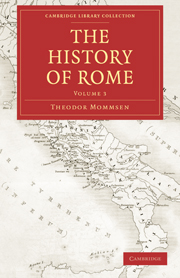Book contents
- Frontmatter
- PREFATORY NOTE
- Contents
- BOOK FOURTH: THE REVOLUTION
- CHAPTER I THE SUBJECT COUNTRIES DOWN TO THE TIMES OF THE GRACCHI
- CHAPTER II THE REFORM MOVEMENT AND TIBERIUS GRACCHUS
- CHAPTER III THE REVOLUTION AND GAIUS GRACCHUS
- CHAPTER IV THE RULE OF THE RESTORATION
- CHAPTER V THE PEOPLES OF THE NORTH
- CHAPTER VI THE ATTEMPT OF MARIUS AT REVOLUTION AND THE ATTEMPT OF DRUSUS AT REFORM
- CHAPTER VII THE REVOLT OF THE ITALIANS AND THE SULPICIAN REVOLUTION
- CHAPTER VIII THE EAST AND KING MITHRADATES
- CHAPTER IX CINNA AND SULLA
- CHAPTER X THE SULLAN CONSTITUTION
- CHAPTER XI THE COMMONWEALTH AND ITS ECONOMY
- CHAPTER XII NATIONALITY, RELIGION, AND EDUCATION
- CHAPTER XIII LITERATURE AND ART
- CORRECTIONS
CHAPTER I - THE SUBJECT COUNTRIES DOWN TO THE TIMES OF THE GRACCHI
Published online by Cambridge University Press: 05 October 2010
- Frontmatter
- PREFATORY NOTE
- Contents
- BOOK FOURTH: THE REVOLUTION
- CHAPTER I THE SUBJECT COUNTRIES DOWN TO THE TIMES OF THE GRACCHI
- CHAPTER II THE REFORM MOVEMENT AND TIBERIUS GRACCHUS
- CHAPTER III THE REVOLUTION AND GAIUS GRACCHUS
- CHAPTER IV THE RULE OF THE RESTORATION
- CHAPTER V THE PEOPLES OF THE NORTH
- CHAPTER VI THE ATTEMPT OF MARIUS AT REVOLUTION AND THE ATTEMPT OF DRUSUS AT REFORM
- CHAPTER VII THE REVOLT OF THE ITALIANS AND THE SULPICIAN REVOLUTION
- CHAPTER VIII THE EAST AND KING MITHRADATES
- CHAPTER IX CINNA AND SULLA
- CHAPTER X THE SULLAN CONSTITUTION
- CHAPTER XI THE COMMONWEALTH AND ITS ECONOMY
- CHAPTER XII NATIONALITY, RELIGION, AND EDUCATION
- CHAPTER XIII LITERATURE AND ART
- CORRECTIONS
Summary
The Subjects
On the abolition of the Macedonian monarchy, the supremacy of Rome was not only an established fact from the Pillars of Hercules to the mouths of the Nile and the Orontes, but, as if it were the final decree of fate, pressed on the nations with all the weight of an inevitable necessity, and seemed to leave them merely the choice of perishing in hopeless resistance or in hopeless endurance. If history were not entitled to insist that the earnest reader should accompany her through good and evil days, through landscapes of winter as well as of spring, the historian might be tempted to shun the cheerless task of tracing the manifold and yet monotonous turns of this struggle between power and weakness, both in the Spanish provinces already annexed to the Roman empire and in the African, Hellenic, and Asiatic territories which were still treated as clients of Rome. But, however unimportant and subordinate the individual conflicts may appear, they possess collectively a deep historical significance; and, in particular, the state of things in Italy at this period is only intelligible in the light of the reaction which the provinces exercised over the mother-country.
Spain
In addition to the territories which may be regarded as natural appendages of Italy—in which, however, the natives were still far from being completely subdued, and Ligurians, Sardinians, and Corsicans were, not greatly to the credit of Rome, continually furnishing occasion for “village-triumphs”—the formal sovereignty of Rome at the commencement of this period was established only in the two Spanish provinces, which embraced the larger eastern and southern portions of the peninsula beyond the Pyrenees.
- Type
- Chapter
- Information
- The History of Rome , pp. 3 - 70Publisher: Cambridge University PressPrint publication year: 2010First published in: 1863

